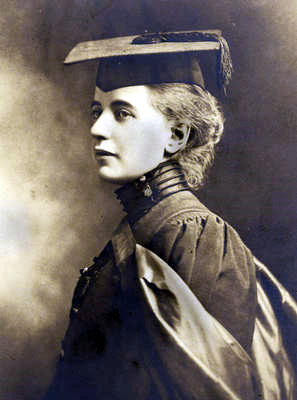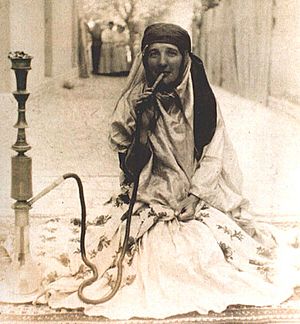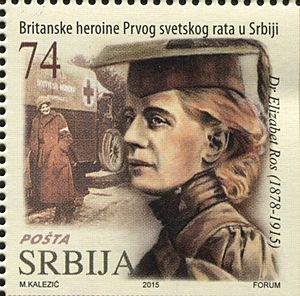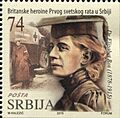Elizabeth Ness MacBean Ross facts for kids
Quick facts for kids
Elizabeth Ness MacBean Ross
|
|
|---|---|

Graduation portrait
|
|
| Born |
Elizabeth Ness MacBean Ross
14 February 1878 London, England
|
| Died | 14 February 1915 (aged 37) Kragujevac, Serbia
|
| Cause of death | Typhus |
| Nationality | British |
| Education | Tain Royal Academy University of Glasgow |
| Occupation | Physician |
| Known for | Medical work in Persia Treatment of typhus in Serbia |
Elizabeth Ness MacBean Ross (born February 14, 1878 – died February 14, 1915) was a brave Scottish doctor. She worked far away in Persia (now called Iran) helping the Bakhtiari people. Dr. Ross also had special training in tropical medicine. In 1915, she answered a call for doctors from the Serbian government. She helped many Serbian soldiers and people who were sick with typhus. Today, Dr. Ross is remembered with a special plaque in her hometown of Tain. People in Serbia also hold ceremonies every year on February 14th to honor her.
Contents
Who Was Elizabeth Ross?
Elizabeth Ness MacBean Ross was born in Hampstead, London. Her parents were Scottish. Her father, Donald Alexander MacBean Ross, was a bank manager from Inverness. Her mother, Elizabeth Wilson Ross, was from Tain.
When Elizabeth's father passed away, her family moved to Tain. She attended Tain Royal Academy there. Later, in 1896, she went to Queen Margaret College, Glasgow to study medicine. She earned her medical degree (MB ChB) in 1901. This was just a few years after Marion Gilchrist became the first woman to graduate in medicine from a Scottish university.
Elizabeth had a sister named Lucy who also became a doctor. Her brother, James Ness MacBean Ross, was a naval doctor. He received special awards for his bravery during the First World War.
Dr. Ross's Early Career
After finishing medical school, Dr. Ross worked in Tain. She also worked as a medical officer on the Scottish island of Colonsay. Then, she spent a year and a half working in East Ham in London.
She later took a job in Isfahan province in Persia. She worked as an assistant to another doctor before starting her own practice. When she returned to the UK for a visit, she passed an exam to get a special diploma in Tropical Medicine. This training helped her treat diseases common in hot climates.
When she went back to Persia, she met Samsam al-Saltane. He was the prime minister of Persia. He suggested she work with the Bakhtiari people in southwest Persia.
Dr. Ross learned their customs and even wore their traditional clothes. She became so much a part of their community that she was made an honorary chief of the Bakhtiari. She wrote a book about her time there called A Lady Doctor in Bakhtiari Land. It was published after her death by her brother James. The book shared important details about the lives of these strong tribesmen.
In 1913, she became a ship's doctor on the SS Nigaristan to travel home. She then worked on another ship, the SS Glenlogan. This job took her to India and Japan before she returned to Isfahan in 1914.
Helping in Serbia During Wartime
When the First World War began, Dr. Ross learned that Serbia desperately needed doctors. The war had caused many injuries to Serbian soldiers. Also, a terrible typhus epidemic was spreading among both soldiers and regular people. Typhus is a serious disease carried by lice. The epidemic was worst in March 1915. About 150,000 people were sick, and around 30,000 died.
Elizabeth Ross arrived in Serbia in January 1915. She volunteered to work in Kragujevac, which was the city most affected by the disease. The large military hospital where she worked was very crowded with typhus patients. A nurse named Louise Fraser visited Dr. Ross there. She said the hospital wards were incredibly dirty and messy.
At that time, doctors didn't fully understand how typhus spread. But they knew that cleanliness, disinfection, and keeping sick people separate were important. It was very hard to do these things in the Kragujevac hospital. Many people died from typhus there, sometimes as many as 40 to 50 out of every 100 sick people.
Dr. Ross's Legacy
Dr. Ross sadly died from typhus on her 37th birthday, February 14, 1915. This was just three weeks after she arrived in Kragujevac. She is buried in the cemetery in Kragujevac. Her gravestone has a message in Serbian that says: "In memory of Dr. E. Ross and two nurses who died in 1915 in our town while attending to our ill and wounded soldiers. Grateful soldiers from the Saloniki front."
There is also a special plaque in her memory at St Duthac's Church in Tain. It says that hospital beds were paid for in Serbia in her honor. This was to remember her noble life and sacrifice.
In 2015, Serbia Post released a set of postage stamps. Dr. Ross was one of six British women featured on these stamps.
The local Red Cross youth group in Kragujevac is named the Dr Elizabeth Ross Society. Every year, during their memorial ceremony, they wear t-shirts with Dr. Ross's graduation picture. A street in Kragujevac is also named Elizabeth Ross Street to honor her. On February 14th, her birthday and the day she died, memorial ceremonies are held each year in Kragujevac and other places in Serbia. These events remember her important work for the people of Serbia.
Images for kids





